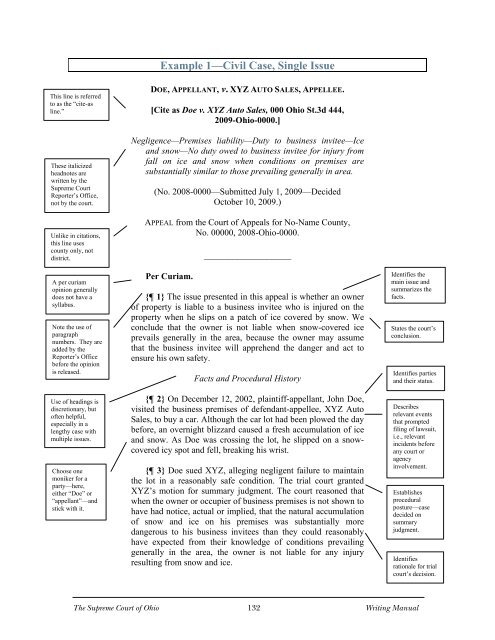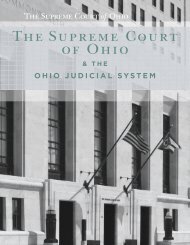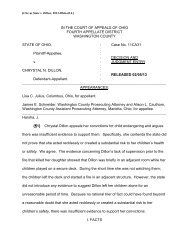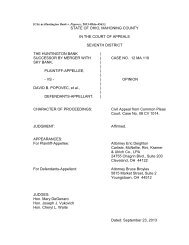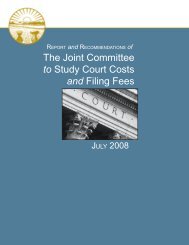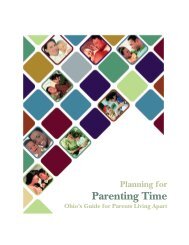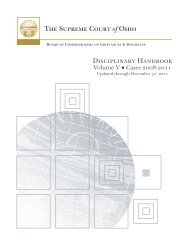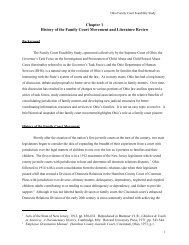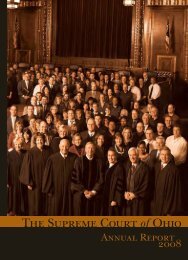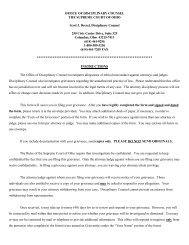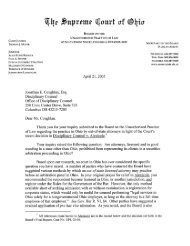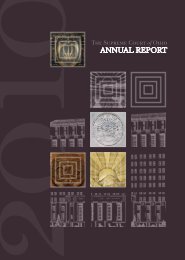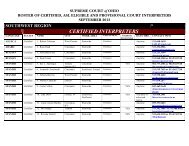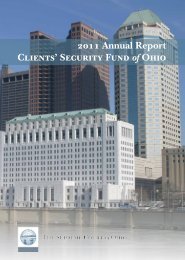WRITING MANUAL - Supreme Court - State of Ohio
WRITING MANUAL - Supreme Court - State of Ohio
WRITING MANUAL - Supreme Court - State of Ohio
Create successful ePaper yourself
Turn your PDF publications into a flip-book with our unique Google optimized e-Paper software.
Example 1—Civil Case, Single Issue<br />
This line is referred<br />
to as the “cite-as<br />
line.”<br />
These italicized<br />
headnotes are<br />
written by the<br />
<strong>Supreme</strong> <strong>Court</strong><br />
Reporter’s Office,<br />
not by the court.<br />
Unlike in citations,<br />
this line uses<br />
county only, not<br />
district.<br />
A per curiam<br />
opinion generally<br />
does not have a<br />
syllabus.<br />
Note the use <strong>of</strong><br />
paragraph<br />
numbers. They are<br />
added by the<br />
Reporter’s Office<br />
before the opinion<br />
is released.<br />
Use <strong>of</strong> headings is<br />
discretionary, but<br />
<strong>of</strong>ten helpful,<br />
especially in a<br />
lengthy case with<br />
multiple issues.<br />
Choose one<br />
moniker for a<br />
party—here,<br />
either “Doe” or<br />
“appellant”—and<br />
stick with it.<br />
DOE, APPELLANT, v. XYZ AUTO SALES, APPELLEE.<br />
[Cite as Doe v. XYZ Auto Sales, 000 <strong>Ohio</strong> St.3d 444,<br />
2009-<strong>Ohio</strong>-0000.]<br />
Negligence—Premises liability—Duty to business invitee—Ice<br />
and snow—No duty owed to business invitee for injury from<br />
fall on ice and snow when conditions on premises are<br />
substantially similar to those prevailing generally in area.<br />
(No. 2008-0000—Submitted July 1, 2009—Decided<br />
October 10, 2009.)<br />
APPEAL from the <strong>Court</strong> <strong>of</strong> Appeals for No-Name County,<br />
No. 00000, 2008-<strong>Ohio</strong>-0000.<br />
Per Curiam.<br />
__________________<br />
{ 1} The issue presented in this appeal is whether an owner<br />
<strong>of</strong> property is liable to a business invitee who is injured on the<br />
property when he slips on a patch <strong>of</strong> ice covered by snow. We<br />
conclude that the owner is not liable when snow-covered ice<br />
prevails generally in the area, because the owner may assume<br />
that the business invitee will apprehend the danger and act to<br />
ensure his own safety.<br />
Facts and Procedural History<br />
{ 2} On December 12, 2002, plaintiff-appellant, John Doe,<br />
visited the business premises <strong>of</strong> defendant-appellee, XYZ Auto<br />
Sales, to buy a car. Although the car lot had been plowed the day<br />
before, an overnight blizzard caused a fresh accumulation <strong>of</strong> ice<br />
and snow. As Doe was crossing the lot, he slipped on a snowcovered<br />
icy spot and fell, breaking his wrist.<br />
{ 3} Doe sued XYZ, alleging negligent failure to maintain<br />
the lot in a reasonably safe condition. The trial court granted<br />
XYZ’s motion for summary judgment. The court reasoned that<br />
when the owner or occupier <strong>of</strong> business premises is not shown to<br />
have had notice, actual or implied, that the natural accumulation<br />
<strong>of</strong> snow and ice on his premises was substantially more<br />
dangerous to his business invitees than they could reasonably<br />
have expected from their knowledge <strong>of</strong> conditions prevailing<br />
generally in the area, the owner is not liable for any injury<br />
resulting from snow and ice.<br />
Identifies the<br />
main issue and<br />
summarizes the<br />
facts.<br />
<strong>State</strong>s the court’s<br />
conclusion.<br />
Identifies parties<br />
and their status.<br />
Describes<br />
relevant events<br />
that prompted<br />
filing <strong>of</strong> lawsuit,<br />
i.e., relevant<br />
incidents before<br />
any court or<br />
agency<br />
involvement.<br />
Establishes<br />
procedural<br />
posture—case<br />
decided on<br />
summary<br />
judgment.<br />
Identifies<br />
rationale for trial<br />
court’s decision.<br />
The <strong>Supreme</strong> <strong>Court</strong> <strong>of</strong> <strong>Ohio</strong> 132 Writing Manual


